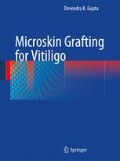Abstract
In vitiligo, there is a partial or total destruction of melanocytes, initially only of the epidermis, and later even of the hair follicle, which acts as a reservoir for providing melanocytes during repigmentation.1 Hence, in patients with vitiligo, the existing melanocytes need to be activated. While medical therapies are the primary treatment, there are some patients refractory to medical treatment. In such patients, surgical therapies can be used either alone or in conjunction with medical therapy to achieve repigmentation, provided the disease is stable. Three types of surgical techniques are available: excision with primary closure, tissue grafts and cellular grafts, with in between autologous cultured epithelial grafts for the repopulation of depleted melanocytes in vitiligo. With tissue grafts, only a limited surface area can be treated, but with good results in a majority of cases. Starting from autologous cellular suspensions, epithelial grafts of various compositions can be cultured in vitro. The cellular grafts can be used for larger areas.
Keywords
These keywords were added by machine and not by the authors. This process is experimental and the keywords may be updated as the learning algorithm improves.
In vitiligo, there is a partial or total destruction of melanocytes, initially only of the epidermis, and later even of the hair follicle, which acts as a reservoir for providing melanocytes during repigmentation. 1 Hence, in patients with vitiligo, the existing melanocytes need to be activated. While medical therapies are the primary treatment, there are some patients refractory to medical treatment. In such patients, surgical therapies can be used either alone or in conjunction with medical therapy to achieve repigmentation, provided the disease is stable.
Three types of surgical techniques are available: excision with primary closure, tissue grafts and cellular grafts, with in between autologous cultured epithelial grafts for the repopulation of depleted melanocytes in vitiligo. With tissue grafts, only a limited surface area can be treated, but with good results in a majority of cases. Starting from autologous cellular suspensions, epithelial grafts of various compositions can be cultured in vitro. The cellular grafts can be used for larger areas.
For convenience, the tissue grafts and cellular grafts can be classified as follows:
1 Classification of Tissue Grafts2
Tissue grafts (Fig. 3. 1):
-
Split-thickness skin graft (STSG)
-
Full thickness skin graft (FTSG)
1.1 Split-Thickness Skin Grafts (STSG) (Fig. 3. 1)
In free split thickness skin sheet graft, the epidermis or the epidermis and varying thickness of dermis are cut during harvesting of graft (Detail in Chapter 5 & 6).
-
Split-thickness skin graft-blister epidermis (STSG-BE)
-
Split-thickness skin graft-ultra-thin (STSG-UT)
-
Split-thickness skin graft-thin (STSG-T)
-
Split-thickness skin graft-medium (STSG-M)
-
Split-thickness skin graft-thick (STSG-THK)
1.2 Full Thickness Skin Graft (FTSG) (Fig. 3. 1)
In FTSG, the epidermis and full thickness of dermis are cut during graft harvesting. FTSG can be cut as small disc of epidermis along with full dermis, so called MPG, for transplantation for repigmentory surgery of vitiligo. HFG is like MPG but it contain a single hair follicle and a thin sleeve of epidermis and full dermis. (Detail in Chapter 7).
-
Mini-punch graft (MPG)
-
Hair follicular graft (HFG)
2 Classification of Cellular Grafts
These cellular grafts can be conveniently classified into cultured or non cultured epidermal cell suspension or cultured cells in sheet form.
-
Noncultured epidermal cell suspension (NCES)
-
Cultured “pure” melanocytes (CM)
-
Cultured epithelial grafts (CE)
References
Falabella R. Surgical treatment of vitiligo: why, when and how. J Eur Acad Dermatol Venereol. 2003;17:518–520.
Prasad D, Gupta S. Standard guidelines of care for vitiligo surgery. Indian J Dermatol Venereol Leprol. 2008;74: S37–S45.
Rights and permissions
Copyright information
© 2009 Springer Dordrecht Heidelberg London New York
About this chapter
Cite this chapter
(2009). Classification of Surgical Treatment Modalities. In: Microskin Grafting for Vitiligo. Springer, London. https://doi.org/10.1007/978-1-84882-605-2_3
Download citation
DOI: https://doi.org/10.1007/978-1-84882-605-2_3
Publisher Name: Springer, London
Print ISBN: 978-1-84882-604-5
Online ISBN: 978-1-84882-605-2
eBook Packages: MedicineMedicine (R0)


